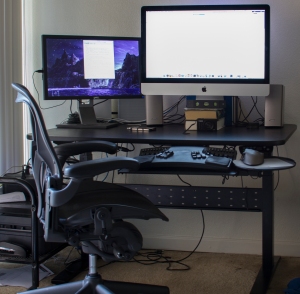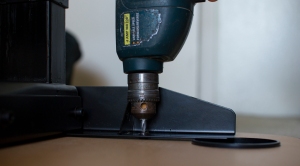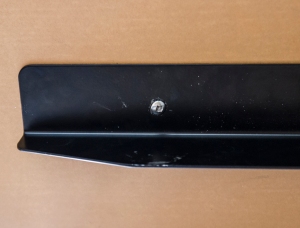The single, most important thing about this GeekDesk review can be encapsulated in a single sentence: I’d never return, full-time and voluntarily, to a conventional desk. The rest is mere commentary. Detailed commentary, to be sure, but the important stuff should be up front.
I’m going to divide this review into two major sections: the first is about using the sit-stand desk, and the second is about installing it.
Usage
 There is by now extensive evidence that sitting for long periods of time is terrible for both health and for concentration. The former has only recently hit the news; see this New York Times story or “The health hazards of sitting” from The Washington Post. Others may be easily found. Yet standing for long periods is also unlikely to be good for you, as anyone who has worked retail or restaurants already knows. Hence the sit-stand desk. Sites like Hacker News are rife with testimonials about standers. Let me add to the cacophony.
There is by now extensive evidence that sitting for long periods of time is terrible for both health and for concentration. The former has only recently hit the news; see this New York Times story or “The health hazards of sitting” from The Washington Post. Others may be easily found. Yet standing for long periods is also unlikely to be good for you, as anyone who has worked retail or restaurants already knows. Hence the sit-stand desk. Sites like Hacker News are rife with testimonials about standers. Let me add to the cacophony.
The latter issue—concentration—is less easily measured, but many of us who do brainwork at desks know the impossible-to-ignore feeling that we must stand and pace. A standing desk facilitates that kind of concentration.
For a long time I got a magical “wow” feeling when I tire of standing and watch the desk lower, or when I tire of sitting and watch the desk rise. Very few products of any sort offer that “Wow.” By now, however, having a sit-stand desk is mundane. We can acclimate to almost anything—and in one particular domain acclimation is called the “Coolidge Effect“— but, as mentioned earlier, I wouldn’t want to go back.
Like any sort of change there is a break-in period, and someone used to sitting for most of the day shouldn’t go to standing for most of it. Start with half an hour or an hour at a time. To the extent I have a method it’s simple: when I’m tired of standing I sit and vice-versa.
 One other point: pretty much everyone I’ve seen who has tried a mat recommends getting a mat (see, for example, this thread for a wide array of testimonials). I haven’t seen anyone who tried a mat and didn’t like or recommend one. The good ones cost at least $60. Geekdesk now sells a mat, and I’m sure theirs is fine.
One other point: pretty much everyone I’ve seen who has tried a mat recommends getting a mat (see, for example, this thread for a wide array of testimonials). I haven’t seen anyone who tried a mat and didn’t like or recommend one. The good ones cost at least $60. Geekdesk now sells a mat, and I’m sure theirs is fine.
Otherwise, I don’t have much to report about usage—which is probably good; like any tool, a desk exists to support some other end. The memory feature on the GeekDesk Max works well. I haven’t thought about it in ages. The desk’s motor (or, more properly, motors: I believe it has one in each leg) is quiet and smooth. In the years I’ve had mine I’ve discerned no changes in the quality of the motor. I suppose it could die tomorrow, and the official warranty is only for two years, but GeekDesk seems like the kind of company that’ll either replace the desk if it dies the day after the warranty expires or cut you a deal on a new one. More on the quality of the company is below.
My desk also has a Humanscale keyboard tray attached. The Humanscale systems have become much more expensive since I bought mine, but I don’t know much about the alternatives. I do know that used versions are available on eBay and Craigslist. I also know that the keyboard trays will last for decades because my parents originally bought ones about twenty years ago. Most of the keyboard trays also offer 360 degree ranges of motions, which can be handy.
The motor—or more properly motors, because I believe there is one in each leg—is still quiet and smooth after about two years of use.
Cost
I like to imagine money spent on computer / desk setups to be allocated pretty damn well, considering how many hours a week I spend working at a computer. But people are funny about money: Dan Ariely describes some of the ways people mis-allocate money based on anchor points in Predictably Irrational.
Most people, if you press them, have some important indulgence they think “worth” spending money on. It might be shoes, lingerie, cars, boats, sports, travel, or hobbies, but it’s almost always there. The surprise at the expense of really good desks is, to my mind, an indication of priorities more than any comment on the absolute value or lack thereof in a workspace.
It’s almost impossible to say whether something like this is “worth it” to another person, but the usual points in favor a sit-stand desk are simple: many people spend 20 to 60 hours a week at a desk. On a cost-per-day basis, a good desk costs less than coffee or ramen. Put that way the upfront costs seem much smaller. It is interesting that many people are willing to pay four figures for minor car creature comforts but spend much less on desks or beds, which are often occupied for ten times as long as a car. Nonetheless anchoring effects are strong and perhaps they can’t be overcome.
I don’t know how long the motor on this desk will last. A conventional desk can probably endure for decades, and that’s obviously not true of a desk with moving parts. This desk comes with a two-year warranty. I’m guessing too that GeekDesk the company will either knock some cash off a new version or do something else nice if the desk dies the day after the warranty expires.
Installation
If you’re not accustomed to using power tools and building things on your own, pay the $95 or so to have your desk built for you. If I’d done this, I would’ve saved a lot of time and hassle. When I first bought the desk, I had no idea what I was doing and screwed up the screwing-in process by not having a drill-bit extender. Seems like an obvious point in retrospect, but at the time I messed up in the installation and ended up stripping a screw and installing others at an angle. In addition, although the screws Geekdesk sent were “self-starting,” they should still be installed with pilot holes.
 I’m jumping ahead of myself, and I could tell the long and somewhat boring story about how this happened, but the short version is that I called GeekDesk not really sure about what I’d fucked up. GeekDesk’s customer service is insanely fabulous. About 80 – 85% of the problems were my own damn fault, and I should’ve been more careful when I assembled the desk, and I should’ve been more careful with the screws. But I wasn’t, and when I gave up and punted, Isaiah actually hired the installer at GeekDesk’s expense. I volunteered to pay, but they said they’d do it. Very few companies go this far.
I’m jumping ahead of myself, and I could tell the long and somewhat boring story about how this happened, but the short version is that I called GeekDesk not really sure about what I’d fucked up. GeekDesk’s customer service is insanely fabulous. About 80 – 85% of the problems were my own damn fault, and I should’ve been more careful when I assembled the desk, and I should’ve been more careful with the screws. But I wasn’t, and when I gave up and punted, Isaiah actually hired the installer at GeekDesk’s expense. I volunteered to pay, but they said they’d do it. Very few companies go this far.
The installer was a third-party company; perhaps not surprisingly, GeekDesk does not have a horde of desk installers across the nation. Unfortunately, the guy GeekDesk sent installed the screws at an angle just like I did, and in the process of screwing around (haha!) with them, managed to strip two heads, which then caused him to go to Home Depot for some more screws. This doesn’t inspire confidence in him, or in the self-starting screw system.
 In my case, I’ve seldom had any need to use power tools and am an amateur. But his entire profession involves putting things like desks together correctly. He was also ready to leave the mis-screwed screws, until I pointed out that the desk was still wobbling.
In my case, I’ve seldom had any need to use power tools and am an amateur. But his entire profession involves putting things like desks together correctly. He was also ready to leave the mis-screwed screws, until I pointed out that the desk was still wobbling.
Anyway, for the Humanscale track I drilled small pilot holes, and now the desk doesn’t wobble, provided that it’s braced against a wall sufficient to absorb shock but not so much as to impede the motor. The desk doesn’t feel as solid as the Maxon Series 1000 desk it replaced, but I haven’t notice any monitor shake either.
(A side note: most reviews for newspapers or magazines appear after the writer has tried the product for a few days or weeks. I prefer to write them after a few months or years: that’s often how long it takes to really evaluate value.)
There are other, similar sit-stand desks, like the NextDesk Terra, but it’s $1,500 and I can’t discern any obvious improvements. It’s also wider, at 63 inches, than the GeekDesk. The Wirecutter‘s reviewers like it better; still, I’d rather save the money and use the Geekdesk.
Here is an earlier post on GeekDesk; note the datestamp.
Pingback: 1 – GeekDesk “Max” sit-stand desk review: Two years with a motorized desk – blog.offeryour.com
Reblogged this on peakmemory and commented:
“I’d never return, full-time and voluntarily, to a conventional desk.”
LikeLike
Great write up, thanks for sharing. I show some other options on my blog at: http://getthinktank.com/2015/06/19/standing-desks/
LikeLike
Pingback: Links: Standing desks, Elmore Leonard, leaving academia, bogus sexual assault numbers, and more « The Story's Story
Pingback: Links: Chairs, publishing, Game of Thrones, midlists, and vocational education « The Story's Story
Pingback: Links: Bike sharing, moral panics, social isolation, academic writing, Saturnalia, and more! « The Story's Story
Pingback: Links: The chair, the planet, Ursula K. le Guin, the problems on campus, and more! « The Story's Story